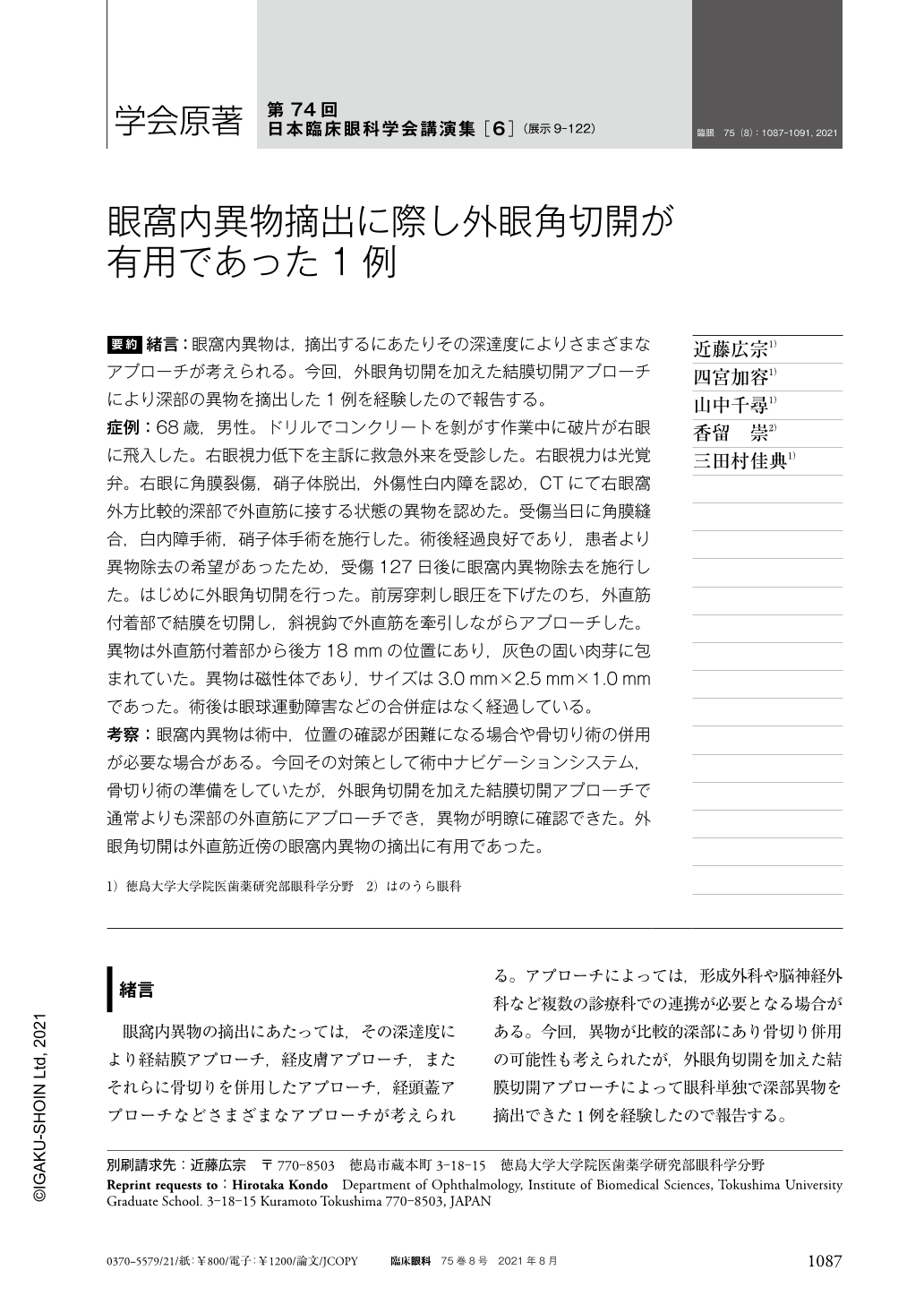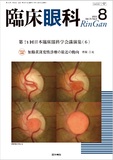Japanese
English
- 有料閲覧
- Abstract 文献概要
- 1ページ目 Look Inside
- 参考文献 Reference
要約 緒言:眼窩内異物は,摘出するにあたりその深達度によりさまざまなアプローチが考えられる。今回,外眼角切開を加えた結膜切開アプローチにより深部の異物を摘出した1例を経験したので報告する。
症例:68歳,男性。ドリルでコンクリートを剝がす作業中に破片が右眼に飛入した。右眼視力低下を主訴に救急外来を受診した。右眼視力は光覚弁。右眼に角膜裂傷,硝子体脱出,外傷性白内障を認め,CTにて右眼窩外方比較的深部で外直筋に接する状態の異物を認めた。受傷当日に角膜縫合,白内障手術,硝子体手術を施行した。術後経過良好であり,患者より異物除去の希望があったため,受傷127日後に眼窩内異物除去を施行した。はじめに外眼角切開を行った。前房穿刺し眼圧を下げたのち,外直筋付着部で結膜を切開し,斜視鈎で外直筋を牽引しながらアプローチした。異物は外直筋付着部から後方18mmの位置にあり,灰色の固い肉芽に包まれていた。異物は磁性体であり,サイズは3.0mm×2.5mm×1.0mmであった。術後は眼球運動障害などの合併症はなく経過している。
考察:眼窩内異物は術中,位置の確認が困難になる場合や骨切り術の併用が必要な場合がある。今回その対策として術中ナビゲーションシステム,骨切り術の準備をしていたが,外眼角切開を加えた結膜切開アプローチで通常よりも深部の外直筋にアプローチでき,異物が明瞭に確認できた。外眼角切開は外直筋近傍の眼窩内異物の摘出に有用であった。
Abstract Introduction:Various approaches can be considered for removing foreign bodies from the orbit. We report a case in which a deep located foreign body was removed by a conjunctival incision approach with lateral canthotomy.
Case:A 68-year-old man. While removing concrete with a drill, debris rushed into his right eye. An emergency consultation was made with the chief complaint of decreased right vision. Visual acuity of the right eye was light perception. A corneal laceration, vitreous prolapse, and traumatic cataract were observed in the right eye. CT revealed a foreign body in contact with the lateral rectus muscle in a relatively deep part outside the right orbit. On the day of the injury, corneal suturing, cataract surgery, and vitreous surgery were performed. The postoperative course was uneventful, and the patient requested removal of the foreign body. At 127 days after the injury, the foreign body was removed. First, lateral canthotomy was performed. After paracentesis was performed to reduce intraocular pressure, the conjunctiva was incised at the attachment of the lateral rectus muscle using a squint hook. The foreign body was located 18 mm posterior to the attachment of the lateral rectus muscle and was wrapped in hard gray granulation. The foreign body was magnetic and 3.0 mm×2.5 mm×1.0 mm. The postoperative course had involved no complications such as ocular motility disorder.
Discussion:Intraorbital foreign bodies may be difficult to localize during surgery or may require the combined use of osteotomy. As a countermeasure, we were prepared to use an intraoperative navigation system and osteotomy, but the conjunctival incision approach with lateral canthotomy made the surgical field wider and enabled confirmation of the foreign body. This case demonstrates that lateral canthotomy is useful for removing orbital foreign bodies.

Copyright © 2021, Igaku-Shoin Ltd. All rights reserved.


